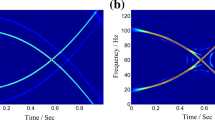Abstract
Instantaneous frequency (IF) is the most important parameter of a signal, which is an important representation of non-stationary signals, such as frequency-modulated signals. Usually, signals are received with noises. Under noise environment, the conventional IF estimation methods for nonlinear frequency-modulated (NLFM) signal cannot work. In this paper, we focus on how to extract IF of NLFM signal under strong noise environment. First, a modified S-method (SM) is proposed to represent the time–frequency (TF) characteristic. The modified SM uses an adaptive smooth window. The symmetric window is used for multi-component signals and asymmetric window for mono-component signals. The modified SM enhances the TF energy concentration and suppresses the cross-terms effectively. Then, the Viterbi algorithm is used to extract the IF from the TF plane. Viterbi algorithm is a hidden Markov chain approach, which is proposed here as the IF estimator. The proposed method is utilized for various types of NLFM signals. Simulation results demonstrate the efficiency and validity of the proposed method under strong noise environment.




Similar content being viewed by others
References
B. Barkat, Instantaneous frequency estimation of nonlinear frequency-modulated signals in the presence of multiplicative and additive noise. IEEE Trans. Signal Process. 49(10), 2214–2222 (2001)
B. Boashash, Time-Frequency Signal Analysis and Processing—A Comprehensive Reference (Elsevier Science, Oxford, 2003)
B. Boashash, M. Mesbah, Signal enhancement by time–frequency peak filtering. IEEE Trans. Signal Process. 52(4), 927–937 (2004)
B. Boashash, P. O’shea, Use of the cross Wigner–Ville distribution for estimation of instantaneous frequency. IEEE Trans. Signal Process. 41(3), 1439–1445 (1993)
C. De Luigi, E. Moreau, Wigner–Ville and polynomial Wigner–Ville transforms in the estimation of nonlinear FM signal parameters, in IEEE International conference on acoustics, speech and signal processing, vol. 2, pp. 1433–1436, 13–17 May (2002)
I. Djurović, Viterbi algorithm for chirp-rate and instantaneous frequency estimation. Signal Process. 91(5), 1308–1314 (2011)
I. Djurović, L.J. Stanković, An algorithm for the Wigner distribution based instantaneous frequency estimation in a high noise environment. Signal Process. 84(3), 631–643 (2004)
W.J. Fitzgerald, R.L. Smith, A.T. Walden, Nonlinear Nonstationary Signal Processing (Cambridge University Press, Cambridge, 2001)
Z.M. Hussain, B. Boashash, Adaptive instantaneous frequency estimation of multicomponent FM signals using quadratic time-frequency distributions. IEEE Trans. Signal Process. 50(8), 1866–1876 (2002)
V.N. Ivanovic, M. Dakovic, L. Stankovic, Performance of quadratic time–frequency distributions as instantaneous frequency estimators. IEEE Trans. Signal Process. 51(1), 77–89 (2003)
J. Lerga, V. Sucic, Nonlinear IF estimation based on the pseudo WVD adapted using the improved sliding pairwise ICI rule. IEEE Signal Process. Lett. 16(11), 953–956 (2009)
P.E. Pace, Detecting and classifying low probability of intercept radar, 2nd edn. (Artech House, Inc., Norwood, 2009)
V. Popović, M. Daković, T. Thayaparan, L.J. Stanković, SAR image improvements by using the S-method. in IEEE International conference on acoustics, speech and signal processing vol. 3, pp. 177–180, 14–19 (2006)
L.J. Stanković, Quadratic and higher order time-frequency analysis based on the short-time Fourier transform, in Proceedings of the sixth international symposium on signal processing and its applications, Piscataway, IEEE press, vol. 2, pp. 581–582, 13–16 August (2001)
L.J. Stanković, A method for time–frequency analysis. IEEE Trans. Signal Process. 42(1), 225–229 (1994)
T. Thayaparan, L.J. Stanković, C. Wernik, M. Daković, Real-time motion compensation, image formation and image enhancement of moving targets in ISAR and SAR using S-method based approach. IET Signal Process. 2(3), 247–264 (2008)
H. Zhang, G. Bi, W. Yang, S.G. Razul, C.M.S. See, IF estimation of FM signals based on time–frequency image. IEEE Trans. Aerosp. Electron. Syst. 51(1), 326–343 (2015)
Author information
Authors and Affiliations
Corresponding author
Additional information
This research was supported by Science and Technology Foundation of Xi’an University of Architecture and Technology (Grant No. QN1507) and the National Natural Science Foundation of China (Grant No. 61201287).
Rights and permissions
About this article
Cite this article
Jiang, L., Li, L., Zhao, G. et al. Instantaneous Frequency Estimation of Nonlinear Frequency-Modulated Signals Under Strong Noise Environment. Circuits Syst Signal Process 35, 3734–3744 (2016). https://doi.org/10.1007/s00034-015-0230-2
Received:
Revised:
Accepted:
Published:
Issue Date:
DOI: https://doi.org/10.1007/s00034-015-0230-2




